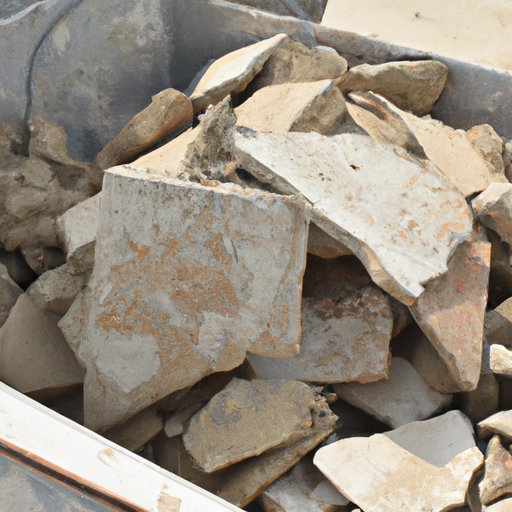
How to Dispose of Concrete: Eco-Friendly Methods
Concrete waste is a common problem resulting from construction projects, home renovations, and landscaping. Improper disposal of concrete can lead to environmental hazards and incur high fees. Fortunately, there are several eco-friendly methods to dispose of concrete that can reduce waste and save money. In this article, we will explore the traditional, recycling, DIY, donation, and upcycling approaches to concrete waste management.
The Traditional Approach
The traditional approach to concrete waste disposal is to hire professionals who specialize in handling and transporting it to designated landfills. Companies such as Waste Management, Republic Services, and Clean Earth are some of the major players in this field. The cost of concrete disposal varies depending on the location, the amount of waste, and the company. However, it typically ranges from $125 to $250 per ton. This can be expensive for large projects or contractors who frequently generate concrete waste.
The Recycling Approach
Recycling concrete is a sustainable approach that can reduce waste and conserve resources. Instead of sending concrete to the landfill, it can be crushed and reused as a base material for roads, parking lots, and building foundations. Reusing concrete not only saves landfill space but also reduces the need for virgin aggregate, which is a non-renewable resource. The process of recycling concrete involves crushing, screening, and sorting it into different sizes. The crushed concrete is then sold to contractors and construction companies for a lower cost than virgin materials.
Recycling concrete has a positive impact on the environment by reducing greenhouse gas emissions, conserving natural resources, and preserving open space. In addition, it can create jobs in the recycling industry. Facilities that accept concrete for recycling include local recycling centers, construction waste recycling companies, and landfills that have recycling programs. Recycling concrete has become more accessible and affordable, making it a popular method for concrete waste management.
The DIY Approach
The DIY approach to disposing of concrete waste is a cost-effective option suitable for small projects or individuals who have the necessary tools and equipment. Breaking up concrete can be a labor-intensive task, and safety precautions should always be taken. The process involves breaking the concrete into manageable pieces, using a sledgehammer or jackhammer, and hauling it away in a trailer or truck. For small amounts of concrete, a demolition hammer or chisel can be used. The broken pieces of concrete can be reused for garden edging, small retaining walls, or even as decorative features in landscaping.
It is essential to remember that concrete is heavy and can be dangerous to handle. Safety gear should be worn, including gloves, eye protection, and sturdy shoes. Careful attention should be paid to lifting and carrying the concrete pieces to avoid accidents. For larger amounts of concrete waste, it may be necessary to rent a dumpster, which can cost around $400 to $800 per week. Check with local regulations to ensure that the disposal of concrete waste in the dumpster is allowed.
The Donation Approach
Donating unwanted concrete to community groups or local construction projects is an eco-friendly option that benefits the environment and the community. By donating the concrete, individuals can save money on disposal costs and contribute to charitable causes. Community groups that accept donations may include community gardens, parks, and schools. Construction companies can also take advantage of donated concrete for road construction, base material, and retaining walls. Contact your local government or construction companies to find out more about donation opportunities.
Donating concrete has several benefits, including diverting waste from landfills, reducing the need for virgin materials, and creating a sense of community involvement. In addition, some organizations provide free disposal of concrete donations, making it a cost-effective solution for individuals and small businesses.
The Upcycling Approach
The upcycling approach to concrete waste management involves converting concrete waste into valuable products or materials. This approach is a creative way to prevent concrete waste from ending up in the landfill and provides an opportunity to add unique features to landscaping and construction projects. Upcycling concrete involves breaking it down into smaller pieces and then repurposing it into functional or decorative items. For example, concrete can be used to create garden stepping stones, retaining walls, and patio furniture. Broken concrete pieces can also be used for landscaping features such as rock gardens and erosion control.
The benefits of upcycling concrete include reducing waste, conserving resources, and adding value to homes and properties. Upcycling projects can also be fun and rewarding, providing a sense of accomplishment and creativity. Taking a few extra steps to repurpose or upcycle concrete waste can make a significant impact on the environment and enhance the overall aesthetic of a landscape or construction project.
Conclusion
Concrete waste management is a crucial aspect of eco-friendly construction, renovation, and landscaping projects. Traditional methods of hiring professionals can be costly, while recycling, DIY, donation, and upcycling approaches offer affordable and sustainable solutions. Recycling and upcycling concrete waste can provide functional and decorative benefits, while donation can serve charitable causes. Taking steps towards eco-friendly concrete waste management can not only reduce negative impacts on the environment but also create positive impacts on the community.




